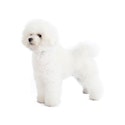Bichon Frise Dog Breed

- Size
- Small
- Height
- 9.5 to 11.5 inches at the shoulders
- Weight
- 12 to 18 lbs.
- Coat
- Medium
- Color
- White and may have shadings of buff, cream or apricot around the ears or on the body
- Energy
- Medium
- Activities
- Conformation, Agility, Obedience, Rally Obedience
The Bichon Frise breed packs an incredible amount of personality into a small but sturdy body. The American Kennel Club (AKC) calls them outstanding “personality dogs.”
Temperament
Gentle-mannered, sensitive and affectionate, the Bichon Frise is an excellent family companion who enjoys the company of children and other dogs.
This playful breed loves activity and requires regular exercise. They are easy to train and eager to perform for the people they love.
Characteristics
The Bichon Frise is a Non-Sporting breed with a plush, snuggly-soft white coat. His curly coat sheds very little, so this breed may be a good choice for allergy sufferers.
The Bichon’s large, dark eyes, and black nose and lips are nestled in an inquisitive round face.
Lifespan
14 to 15 years
Colors
The Bichon Frise’s coat is always white.
Shedding
The Bichon Frise is considered to be a low-shedding breed, because the hair he does shed gets caught in his undercoat. This hair needs to be brushed out, so mats don’t form.
The hair also keeps growing, so this breed needs to be groomed every four to six weeks.
Health
The Bichon Frise is generally a healthy breed, but responsible breeders will check for health conditions such as allergies, bladder infections, luxating patella, and cataracts and other eye diseases.
Bichons also need regular dental care or they can be susceptible to complications from gum infections, such as tooth loss.
Best Dog Food for Bichon Frise Dogs & Puppies
Like other small breeds, Bichons may benefit from a small breed dog food. For Bichons who need help with weight management, consider a healthy weight formula.
Bichon Frise puppies should eat small breed puppy food for their first year of life to aid in their growth and development.
History
The Bichon Frise breed is one of the ancient group of breeds known as the Barbichon types, which also includes the Bolognese, Havanese and Maltese. During the 13th century and into the Renaissance, the breed became favorites of the royal courts of Spain, Italy and France.
During the French Revolution, Bichons lost their privileged status. When these bright, trainable, charismatic dogs were turned out from their pampered homes, they found their place as performers with street entertainers and circuses.
In the wake of two world wars, and the austerities that followed, many Bichons again found themselves without support. The breed survived, thanks to the efforts of enthusiasts who took in dogs from the streets of France and Belgium.
The Bichon Frise breed achieved AKC recognition in the Non-Sporting Group in 1973.
Facts
- “Bichon Frise” is French for “curly lap dog.” “Bichon” is a type of lap dog, and “frise” is French for “curly.”
- The Bichon Frise appears in a number of works by the noted Spanish painter Francisco de Goya.